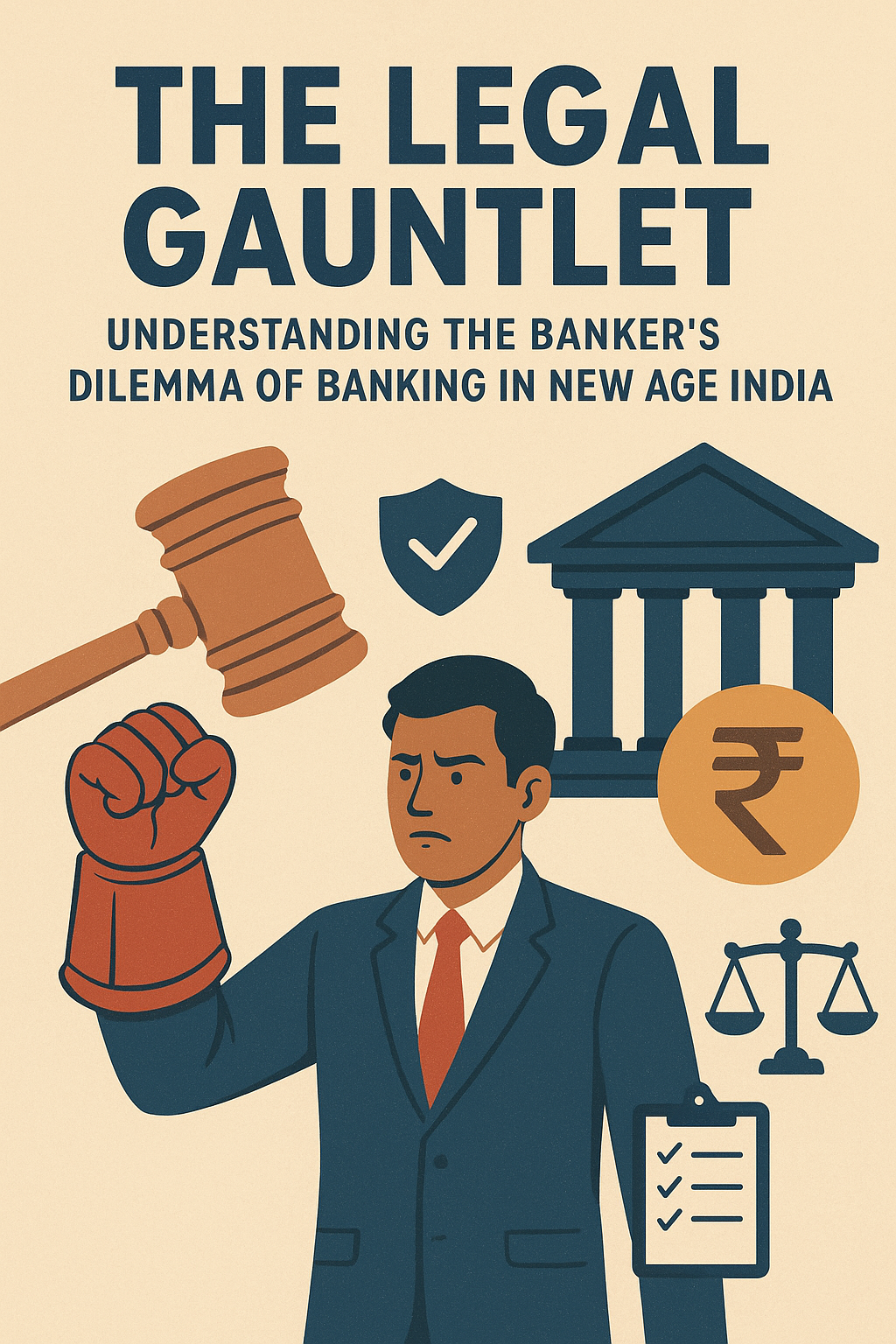View News
The Legal Gauntlet: Understanding the Banker's Dilemma of Banking in New Age India

The Legal Gauntlet: Understanding the Banker's Dilemma of Banking in New Age India
~Sura Anjana Srimayi
INTRODUCTION
India's large financial institutions, especially the "too big to fail" institutions such as State Bank of India (SBI), HDFC Bank, and ICICI Bank, function within a complex and dynamic legal and regulatory framework. Their sheer magnitude and systemic significance imply that their legal issues are not fixed but dynamic, covering a broad spectrum of areas from corporate control and financial integrity to computer security and consumer protection. Success for a bank in this environment is no longer determined by its bottom line but by the extent to which it strives to meticulously comply with an intricate network of statutes, regulations, and judicial rulings.
Corporate Governance and Compliance Navigating
A foundation of a large bank's legal solidity is corporate governance. They are kept on their toes by an abundance of laws and regulatory agencies, led by the Reserve Bank of India (RBI) and the Companies Act, 2013. Such over-burden of compliance proves to be a perpetual source of legal hassles, as banks have to ensure that their in-house organizational arrangements, board mix, and decision-making mechanisms are not only legally correct but also best-in-class. Reports and inquiries have often pointed out problems like the absence of board independence, political interference, and weak internal controls, which can create legal issues and regulatory fines. Complying with the legal requirement of having a transparent and ethical corporate setup is an elementary requirement to do business in India's banking industry.
The second significant legal and operational challenge is dealing with non-performing assets (NPAs). Even after the introduction of the Insolvency and Bankruptcy Code (IBC), the bad loan recovery process continues to be painfully slow and juridically convoluted. Banks have to traverse a messy maze of legal cases, frequently involving lengthy litigation in debt recovery tribunals and other courts, to recover their money. This has a direct bearing on their profitability and stability. The judicial framework for loan recovery is an ongoing battlefield, and banks are forced to use elaborate legal personnel and tactics to make sure that they recover their capital without infringing on due process. The extended duration of these judicial battles creates a major challenge for the financial health of the banks and underscores the necessity of continued institutional and legal reforms in the debt recovery market.
The Changing Nature of Financial Frauds and Cybersecurity
The banking industry's regulatory issues are more and more characterized by the changing nature of the threat of financial crime. High-profile financial frauds, including the notorious Punjab National Bank (PNB) scam, have revealed egregious vulnerabilities in the internal controls, due diligence, and accountability structures of the Indian banking system. These instances always create huge legal battles and regulatory intervention, forcing the banks to completely revamp their fraud detection and prevention systems. They are a stark reminder that a momentary internal lapse can cause enormous legal, financial, and reputational losses.
Also, with the evolution of digital banking, there has been a new and omnipresent legal frontier of cybersecurity. Banks have a statutory mandate to safeguard customer information against theft, fraud, and cybercrime. Since the regulatory framework for data protection in India is in its infancy, banks are engaged in a perpetual fight to deploy cutting-edge security measures and keep up with highly evolved cyber attacks. The legal liability of a breach of data is colossal, and non-adherence can result in stiff penalties from the RBI and other regulators, as well as expensive civil suits from impacted customers. A bank's role in ensuring a secure digital environment is no longer simply a technology imperative but a foundational legal necessity whose absence directly affects its customer trust and long-term sustainability.
The Frontlines of Customer-Centric Legal Issues
Large banks also encounter many legal issues on a daily basis directly connected with their clients. A prominent one is compliance with Know Your Customer (KYC) and Anti-Money Laundering (AML) policies. These standards make banks implement strong customer due diligence mechanisms to avoid financial crimes, and any negligence can lead to serious punishment. The RBI has also, in the past, imposed penalties on large banks, such as ICICI Bank and HDFC Bank, for breaching these important norms, to indicate the seriousness of these legal obligations.
Moreover, there are frequent legal fights over means of recovering debt. Banks have a right to recover their dues but customers have, on several occasions, filed suits against banks for harassment or illegal tactics during recovery. The legal system is frequently in a position of having to resolve these conflicts, establishing precedents around what is acceptable behavior when it comes to debt collection. This serves to hold banks accountable and insulate consumers from unfair pressure or intimidation. Lastly, the legal system is the central arbiter of conflicts involving larger consumer rights, notably around fraudulent transactions and the terms and conditions of banking products. For instance, a client can sue a bank for an unauthorized debit card transaction, or a lender can sue over the fine print of a loan contract. Such cases compel banks to make their products transparent, security mechanisms strong, and their customer communication honest and legally valid.
Emerging Legal Frontiers and Future Debates
With the banking industry still going through growth, new legal issues keep arising. For example, SBI recently requested RBI permission for banks to lend for mergers and acquisitions, which is currently banned. The step, if sanctioned, would provide a new sector of legal and regulatory supervision for banks, prompting them to acquire new expertise and compliance procedures. In the same vein, the legal implications of new technologies such as blockchain and artificial intelligence (AI) within the banking sector are a subject of continuous debate between regulators and attorneys. Utilization of AI within credit scoring, for instance, poses intricate issues relating to algorithmic bias and equity, while the legal status of blockchain technology in asset management and payments is a gray area. These new legal frontiers mean that the legal landscape for banks is a changing and constantly evolving field.
CONCLUSION
India's giant banks confront enormous, dynamic legal and regulatory challenges that are pivotal to their stability. From maintaining effective corporate governance and handling intricate NPA books to safeguarding against advanced financial fraud and evolving to meet new customer-focused legal realities, a bank's success in today's day and age is inherently linked with its legal strength. The capacity to chart through these difficulties by investing in strong compliance mechanisms, adopting technological means for security, and taking an ethical approach to customer dealings is now as important to the long-term survival of a bank as is its bottom line. In the end, the good health of the Indian banking industry is contingent on its absolute commitment to honoring the law and constructing a lasting pillar of public confidence.
Unlock the Potential of Legal Expertise with LegalMantra.net - Your Trusted Legal Consultancy Partner”
Disclaimer: Every effort has been made to avoid errors or omissions in this material in spite of this, errors may creep in. Any mistake, error or discrepancy noted may be brought to our notice which shall be taken care of in the next edition In no event the author shall be liable for any direct indirect, special or incidental damage resulting from or arising out of or in connection with the use of this information Many sources have been considered including Newspapers, Journals, Bare Acts, Case Materials , Charted Secretary, Research Papers etc

